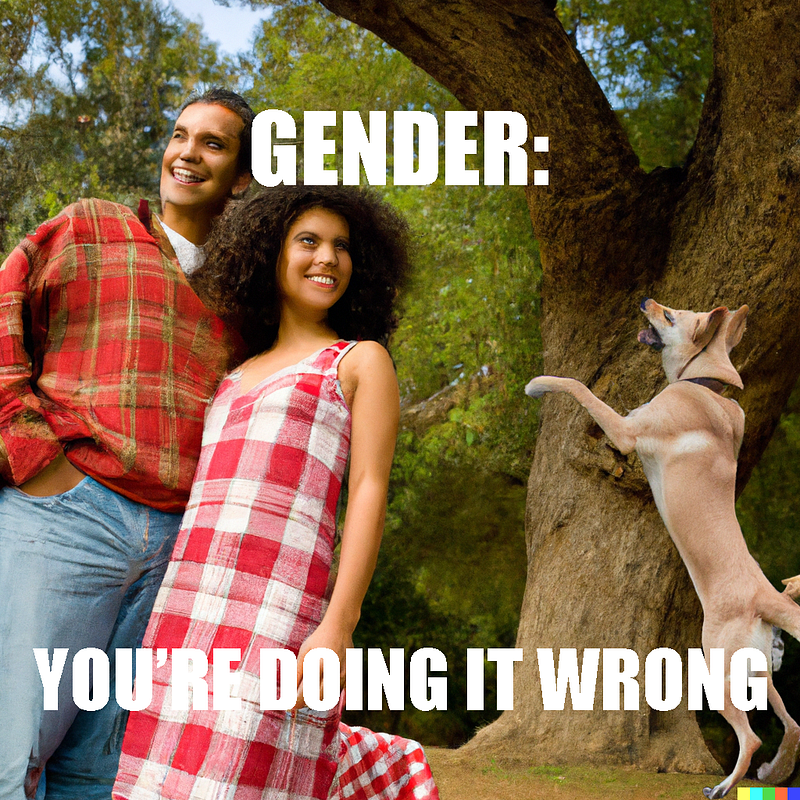Does Gender Dysphoria Make You Transgender?
In a world filled with misinformation, let’s at least fix one of them


In public discussion about gender — particularly transgender — neither side appears capable of making a compelling argument.
On the anti-LGBTQ side, the argument centers on insisting sex and gender are identical concepts. This argument is easily deflated. I detailed the difference in my last two articles: sex is a species-level biological abstraction focused on reproduction; gender is an individual-level mode of expressing sex characteristics, whether they exist or not, focused on social interaction.
But on the transgender side, my community tends to focus on gender dysphoria, with a common cry being “you have to be transgender in order to understand it.” This circular argument is as valid as Supreme Court Justice Potter Stewart’s opinion on pornography, and for the same reasons. Although we create opinions based on intuition, using gut feel to create policy is problematic.
It is no wonder anti-LGBTQ rhetoric discards arguments about gender dysphoria — for the same reason those of us who believe in freedom of expression discarded Justice Stewart’s opinion about pornography.
But gender dysphoria is not a mystery. Each of us develops gender identity — it is a critical component of human development. Sometimes, a mismatch occurs between the way we choose to express ourselves and how well that expression is accepted by those around us.
That mismatch is a simple definition of gender dysphoria.
A more complicated definition of gender dysphoria
Before discussing gender any further, we must understand the experience of dysphoria. The American Psychological Association (APA) defines dysphoria as “a mood characterized by generalized discontent and agitation.” A more general definition includes “dissatisfaction and unease.”
Dysphoria, in itself, is not a disorder, according to the APA. Dysphoria is a symptom associated with complexes that are considered disorders, such as depression and anxiety. But dysphoria is also associated with typical human experiences, such as premenstrual syndrome and general stress.
Dysphoria is neither good nor bad. It is an experience that alerts us to our reaction to a situation that may allow us to address it.
Gender is a complex of human experience. It encompasses our physical structure; our thoughts, emotions, and actions; and how the two are expressed within socio-environmental factors. Gender is expressed as how we look, how we feel, and how we act, especially as informed by acceptance or rejection by the social environment.
Gender dysphoria, then, is dissatisfaction, unease, and discontent with aspects of how we look, feel, or act, especially in context of society.
How gender dysphoria feels
At the risk of sounding like an infomercial announcer…
Have you experienced any situation similar to the following?
- Embarrassment or humiliation because your breasts are too big? Because your breasts are too small?
- Embarrassment or humiliation because your penis is too small?
- The need to “work out” to gain muscle or lose weight in order to look “hot?”
- Humiliation at striking out at a T-ball game and being hooted at as you trudge back to the dugout?
- Humiliation at wearing too much eyeliner or lipstick and being called a whore?
Congratulations! You achieved the dubious honor of feeling gender dysphoria. How? Because in Western society:
- Women are supposed to have breasts precisely the size men like.
- Men are supposed to be virile and have large penises to indicate it.
- Men should be muscular; women should be thin.
- Boys should be good at sports and “shaking it off.”
- Girls should be good at staying in the background and not “asking for it.”
Gender dysphoria entails humiliation for expressing gender in a way the social environment does not welcome. I am confident every person reading this article has experienced gender dysphoria — because those feelings are important human experiences.
Gender dysphoria as social education
Gender is a critical component of identity. And not just human identity — any species that reproduces sexually and establishes social structure requires a concept of gender.
Every organism within a social structure must develop a gender expression…which only becomes problematic if it doesn’t fit the socio-environmental factors in which it is expressed. Nobody is concerned about what you wear to survive as you’re lost on a desert island.
(I originally wrote the line above as “in your cabin in remote Montana,” but I realize anti-LGBTQ legislation is already cracking down on being who you are in private as well.)
Gender dysphoria is a necessary step in human development — both personal development and the evolution of gender characteristics in the social environment. Gender dysphoria gives context to our human experiences. Gender dysphoria allows us to learn what “masculine” and “feminine” mean.
By feeling the humiliation of “gender: you’re doing it wrong,” we learn social norms and mores. We learn how to behave in a way most conducive to social acceptance. Further, because the definitions of “masculine” and “feminine” change as societies do, what causes gender dysphoria contributes to the identity of the society.
For many people, enduring gender dysphoria is temporary and positive. Any corrections are accepted at face value because we want to act in a way we find coherent and integrated.
Transgender as social expression
If gender dysphoria is good, then why did I — as a human born with the capacity to produce sperm — transition from presenting as a man to presenting as a woman? Why didn’t my early humiliation at expressing feminine characteristics stick, as it were?
Just as common discussion has obscured the meaning and value of gender dysphoria, common discussion provides two terms — “cisgender” and “transgender” — to describe whether gender dysphoria is healthy or not.
The prefixes “cis” and “trans” are from the Latin meaning “this side of” or “the other side of,” respectively. The word “cisgender” is used to imply a gender on the same side as sex — that is, a male who presents as a man. The word “transgender” is used to imply a gender on the other side of sex — that is, a male who presents as a woman.
I have discussed at length the false relationship between sex and gender — that one does not follow from or derive from the other. I dislike the terms cisgender and transgender, although I continue to use these terms in spite of scientific inaccuracy because of common understanding. But I emphasize that cisgender does not mean “healthy” and transgender does not mean “disordered.”
Like any gender dysphoria, transgender is characterized by a mismatch of who we know we are on the inside with what we choose to present on the outside. I named this mismatch “The Reflection” early on because transgender is a particularly obvious form of gender dysphoria — the reflection we see in the mirror is different from what we experience in our minds.
But the sensation of gender dysphoria is not the same as transgender.
How transgender feels
Gender dysphoria becomes transgender when it becomes all-pervasive. Transgender is characterized by gender dysphoria that is not temporary and not positive, when the corrections contribute to more dysphoria, less coherence of gender, and less integration of identity.
Clothes cannot hide the bodily features we resent. Makeup cannot hide facial features we despise.
Vocation, friends, hobbies, time alone, time with family, going out, staying in — everything feels like pain. Nothing can make us feel like the person we know we are because we’re not allowed to express it.
Death is a viable alternative to a life lived as a lie.
That is transgender. It’s not just gender dysphoria. It’s mounting, circular, never-ending gender dysphoria. And like any dysphoria, the transgender experience can become pathological — impeding our ability to function as a human within society.
Transgender is greater in magnitude and reach than striking out at a T-ball game. But the two are the same in kind. You know what gender dysphoria feels like. You know what feeling unable to function feels like.
If transgender must be regulated, so also must we regulate those of us who experience depression, premenstrual syndrome, and anxiety — for the same reasons.
Oh, and — Whoopsie Daisies! — we also need to regulate those with personality disorders such as histrionic personality disorder, of which most of the US government could likely be accused — certainly the last President to occupy the White House.




